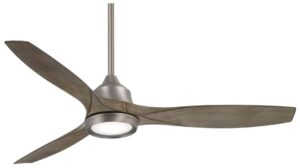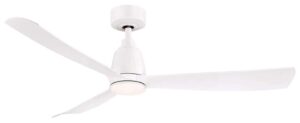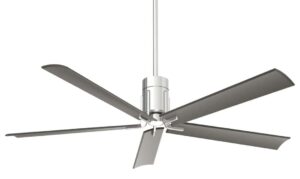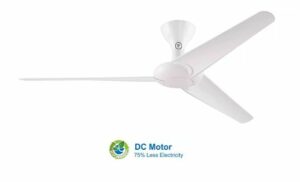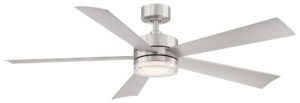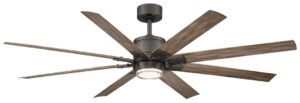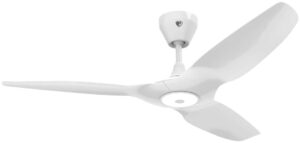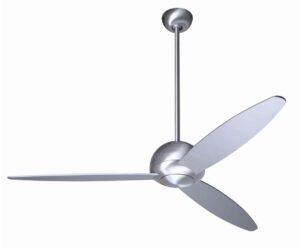Looking for the best modern ceiling fans? Well, look no further! Ceiling fans are becoming more and more advanced these days. They are being designed with more modern aesthetics, as well as technical updates like being compatible with smart home devices. We reviewed dozens of products to bring you the very best ones. Be sure to also scroll to the bottom of this article for an in depth guide on everything you need to know when buying a ceiling fan. We cover everything from downrods, to motor types, to windspeed.
The Minka Aire 60” Shyhawk LED has it all. With its dependable wooden blades, excellent design, and a super-efficient DC motor, this fan ranks conveniently higher against its peers in the same price range. With remote control integration, you don’t have to walk across the room to control your fan. You now have complete control in your hands.
Enjoy an integrated LED light with the capacity to provide over 1649 lumens and with a Color Rendering Index of 92. Not only is it physically impressive to look at, the Skyhawk is also a powerful fan with LED rated to last 30 times longer than a typical incandescent bulb. The Minka Aire is a beauty to behold and to own.
If you want to make a statement with quality, the Minka Aire 60” Skyhawk LED is top tier, with a quality rating of 5 (above the average 3). It’s windspeed is 3.28 MPH. This fan comes with an efficiency rating of 164 CFM/Watt, while consuming only 44 Watts of electricity per hour.
The manufacturer, Minka Aire, is considered one of the finest manufacturing companies when it comes to ceiling fans. They offer the best ceiling fans in the market, focusing on efficiency, durability, and quality. This is a fan brand that absolutely considers style as you can see from their fan designs.
Everything about this fan is specifically designed for efficiency and for your absolute comfort. From the wind speed factor to the electrical usage, the Minka Aire Swept LED is one of the finests in the market. This 4-blade ceiling fan comes with an airflow of 7397 CFM guaranteed to help you really cool off.
The Minka Aire Swept LED is designed for energy efficiency. Consuming just under 30 watts per hour, this ceiling fan will cool you off without burning up your electricity bill. Standing above the average 3 MPH, this ceiling fan comes with a wind speed factor of 3.76 MPH.
When it comes to the quality ratings of this ceiling fan, the numbers are wonderful. A fan so smooth and quiet, it can run for 24 hours everyday for several years, this product will prove to be your finest purchase decision.
The Minka Aire Swept LED in Distressed Koa comes with an efficiency rating of 244 CFM/watt, placing it way ahead of the average rating. If you choose this fan, you also get to enjoy its other exciting features.
Minka Aire is reputed as one of the leading companies in the ceiling fan industry. Their products offer best, most efficient, and cost-friendly results, while also delivering on quality and comfort. With this ceiling fan brand, you can easily fit in a fan of your choice with your interior
A ceiling fan that easily clinches the “Great value” award for ceiling fans, this one will catch your fancy. The Fanimation 52” Kute Modern Fan is one for people who care about style and functionality. This ceiling fan is designed with a wind speed factor of 3.88 MPH and a quality rating of 5/5.
With an Airflow of 6701 CFM, this ceiling fan is guaranteed to keep you cool. The efficiency rating of this ceiling fan is 186 CFM/Watt. It has a 3 blade DC motor which stays quiet and keeps your energy bill low. Its 16 speed motor hits top speed at 171 RPM (revolutions per minute). This fan is mostly for indoor use. However, it carries an outdoor DAMP rating, meaning it can be used as an outdoor fan as long as it doesn’t get direct exposure to rain and other harsh elements. A 4.5″ downrod comes standard with this fan, or you purchase an adapater to flush mount it to your ceiling.
The manufacturer, Fanimation, is one of the leading manufacturing companies when it comes to ceiling fans. Their ceiling fans are designed for durability, efficiency, quality and aesthetics. This is a fan brand you absolutely should consider if you’re shopping for one.
The Minka Aire Clean LED comes in Polished Nickel and gives you the best of both worlds. You get to enjoy ultimate control with its remote powered sensors and also get great quality in the windspeed it generates.
This ceiling fan comes with a RC400 Remote control with 6 Speeds and a full range light dimmer. With a wind speed factor of 4.66 MPH, it is one of the highest rated fans on the market today.
With an Airflow of 10340 CFM, you will absolutely enjoy the air power of this fan. It’s DC motor and LED lights are energy efficient and will save you money on your energy bill for years to come. The manufacturer, Minka Aire, is considered one of the finest manufacturing companies when it comes to ceiling fans. They offer the best ceiling fans in the market, focusing on efficiency, durability, and quality. This is a fan brand that absolutely considers style as you can see from their fan designs.
The Minka Aire Cone Led Ceiling Fan is a beautiful and outdoor friendly ceiling fan. It offers a sophisticated appearance, well-structured, and designed with the most appropriate materials in the most appropriate style. It boasts a WET outdoor rating. Thus, it can be exposed to direct rain and will still function smoothly.
It comes in white with five different blades designed to run smoothly and quietly at a high performance. It will also keep your energy bill down with its energy efficient DC motor. The ceiling fan comes with an integrated dimmable LED light feature, which makes it suitable for outdoor use.
Minka Aire is one of the leading ceiling brands across the world. They build modern 21st century designed ceiling fans that consistently rank among the best.
Design and revolutionary technology together. Through its proprietary fanSync technology and dedicated remote control, you can also control it from a smartphone using Bluetooth and Wi-Fi (Wi-Fi receiver sold separately).
It is also compatible with Alexa and Google Assistant. You can integrate it into your existing IoT devices like amazon echo, Ecobee, Nest, smart things, and Google Home for easy control.
The Fanimation Drone features six speed settings allowing you to control the airflow at its best. Plus, the advanced Fresh Air Mode lets you modulate the RPM and convert regular airflow to a natural breeze.
Located in Zionsville, IN, Fanimation Fans is a technology-driven company that deals with supplying and installing power-efficient & environment-friendly ceiling fans across the states. However, with such design successes, it is sure to spread its business boundary even more.
Stainless Steel fans can be tiring to buy, but not the Modern Forms Wynd 60”. This fan is one of the best fan brands in the market and it is an absolutely beautiful machine. With this fan, you can enjoy both WiFi and Bluetooth control. This is the fan to go for if you are interested in getting quality and control.
The Wind Speed Factor of this fan is 3.23 MPH which gives it a Breeze rating of 4 out of 5. The Wynd 60” is a great quality with an Airflow of 7160 CFM. This allows you to increase your thermostat by a factor of 10 degrees.
If you are interested in efficiency, you should know that this fan is rated 211 CFM/Watt. But what is most appreciable about this fan is the electrical usage of 34 Watts.
Using the Wynd 60” helps you save a huge percentage on your electricity bill. And it comes with a Quality Rating of 5. This is the type of fan you can leave on for 24 hours every day for several years and it would still be durable.
Manufactured by Modern Forms, one of the finest producers of quality fans. They design and manufacture some of the most durable, functional ceiling fans around. And give you the best quality for your money.
The Modern Forms 66″ Renegade Oil Rubbed Bronze Modern Fan is one of the finest when it comes to blade span and function. The DC Motor that controls this fan is a smooth engine that is 70% better than AC fans. But it is the WiFi and Bluetooth control options that this fan has that makes many people prefer it.
The Modern Forms 66” Renegade will work with Amazon Alexa, Google Assistant and a host of others. It is EnergyStar qualified and exceeds the current standards on efficiency. This fan comes with a 5 star quality rating and is very quiet. It can run for years on end without breaking down or burning out because of its superior motors.
If you need a cooling breeze, this fan comes with a Wind Speed Factor of 3.63 MPH. The 66” Renegade is guaranteed to keep you cool on hot days. The 8 bladed DC motor has an airflow of 9540 – one of our favorite features of this ceiling fan. In addition to all that, it comes with an LED light fixture. This is the perfect type of fan for large rooms.
The Haiku L is a 52″ Universal Mount Ceiling fan with LED light and the option of a WiFi Module sold separately. This series is less expensive, but also packs functionality that’s worth your money. Unlike some others, this fan has a hand held remote control transmitter and receiver.
In terms of functionality, this ceiling fan is one of the finest, most dependable in its price range. It comes with a wind speed factor of 3.24 MPH which is above average. It packs an Airflow power of 5604 CFM to keep you cool. And, it has an efficiency Rating of 296 CFM/Watt, which is among the highest among ceiling fans in its range. One of the best things about this fan is its low electrical usage of 19 watts.
If you enjoy style as well as quality functionality, then this fan is for you. It is one of the physically finest and functionally dependable in its range. It comes with three blades, and a 7 speed DC motor which operates quietly and at low energy costs.
Manufactured by Big Ass Fans, a leading brand in ceiling fans manufacturing. This company places a premium quality and aesthetics.
This fan that combines style and performance for use indoors and outdoors. The Modern Fan Plum comes with a wind speed factor of 3.29 MPH and an airflow power of 5679 CFM to keep you cool. These are modest numbers that are about average. If you are looking for a fan to drastically cool your room, you may want to keep looking. It features a 52″ blade span, 3 blades, and an AC motor topping out at 247 RPM (revolutions per minute). This fan is a bit noisier than other DC motor fans, so be sure to keep that under consideration.
This aluminum made fan is certainly a take on a modern looking design. It’s rated primarily for indoor use only. However, it’s DAMP outdoor rating means you may install it outside as long as it isn’t exposed to rain or harsh conditions.
As an affiliate partner, we may earn from qualifying purchases made on these products.
Everything To Know When Buying Modern Ceiling Fans.
We have a deep love for ceiling fans and live to help others understand these products as well as we do. That is why we took the time to write a ceiling fan buyers’ guide.
Buying a modern ceiling fan for the first time can be overwhelming. There are many options for fans and each fan has different styles, sizes, functionality, blades, and installation steps.
Fortunately for you, we have distilled all of the key variables down into an accessible and digestible guide. You can read this guide if you want an in-depth understanding of ceiling fans or you can skim it if you only want to better understand certain aspects of the fan itself.
This includes how to select a fan to buy, the types and angles of a fan’s blades, the pros and cons of the AC and DC motors that power fans, and how to install the fan on your ceiling. If you follow this guide you can be confident that you are making a well informed buying decision.
We know all things ceiling fans and want to pass on our learnings and insights to help you.
Most importantly, we know that once you evaluate, select, and install a ceiling fan it will likely remain in place for many years to come. That is because ceiling fans can be heavy, expensive, and labor intensive to install.
What is a modern ceiling fan?
Modern ceiling fans, also known as mid-century or contemporary ceiling fans, have a certain look. That look is characterized by sleek blades, a minimalistic design ethic, simplicity, and strong lines.
There are many different types of modern ceiling fans because the definition of what contemporary encompases is broad.
Modern ceiling fans can be made of metal or wood and have any number of blades. To classify as mid-century, the lines on the fan need to be sleek and bold: the cut of the material needs to be strong looking and minimalist.
A central air conditioning system consumes 3 kiloWatts, which is about 36 cents per hour. Running a fan only runs at 30 Watts, equivalent to only a cent per hour.
This makes modern ceiling fans affordable and energy efficient alternatives that many people love as they are good for you, your wallet, and the environment.
Running a fan that turns off when a certain temperature range is reached is even more affordable.
Take the time to do research now before buying because the switching costs of changing your mind can be high.
Go through this evaluation check-list so that you better understand the types of motors, blades, installation units, and fans that exist. We encourage you to optimize for:
- Overall quality: in particular the speed of the motor to optimize for cooling efficacy and quietness.
- Aesthetics: in particular ensure that you are happy with how the fan looks, its color, shape, design, and blade count.
- Size: select the right size fan for the room you will be placing it in. Larger rooms require larger fans to create strong air flow.
Selecting the location of modern ceiling fans: Inside or Outside
Most modern ceiling fans are used within the home. Others are for outdoor structures. Before deciding which type of fan to buy, determine where you will place it. Understanding the placement of a ceiling fan will help you select other attributes – like size, speed, and sound – that will enhance your experience with the fan.
Outdoor fans require different electrical strategies and water-proof finishes. Please keep this mind throughout the guide as we largely focus our attention and advice to those people who want to install indoor fans.
It is my professional opinion that modern ceiling fans are too “classy” to be used outside. They compliment interior design and architecture and therefore are almost always found within homes.
If placing the moden ceiling fan in an indoor room, measure the size of the room.
Bathrooms tend to be smaller than bedrooms which tend to be smaller than living rooms or kitchens.
Knowing the approximate size of the room in which the fan will be placed is important.
Larger fans are best suited to larger rooms as their blades and motors move greater volumes of air.
Ceiling Fan Size Chart
| Room (in feet) | Cubic Feet/Minute | Fan Size |
| 6′ x 6′ | 3,000 – 4,500 | Shop: 24″ to 36″ |
| 10′ x 10′ | 4,000 – 5,500 | Shop: 37″ to 48″ |
| 12′ x 12′ | 6,200 – 7,500 | Shop: 49″ to 56″ |
| 15′ x 15′ | 7,000 – 9,000 | Shop: 60″ to 72″ |
| Larger | 9,000 – 11,000 | Shop: 80″ to 99″ |
The length of the blade of the fan and the size of the room go hand in hand.
In short, if you have a large room, buy a larger fan. The bigger the fan the better.
The common sizes for ceiling fans are 36, 44 and 52 inches, with the large fans having a blade wingspan of 60 inches.
Of course you can technically go even larger, with the largest recreational home fans having up to 99 inches of wingspan.
99 inches is 8.25 feet. That is a large modern fan indeed.
Measure the height of the ceiling and allow at least 7 feet and 6 inches of space.
It is wise and safe to place your fan at least 7 feet above your flooring.
Placing a modern ceiling fan high up protects tall individuals from hitting their head or having their hair caught while the fan is in motion. Fans need to be installed on ceilings and these installation bases take space as well.
An installation base is adjoined to a downrod, which is a simple piece of metal that the fan is connected to and hangs from.
The average American ceiling height today is 9 feet (2.7432 meters). This means that the average room can support a fan but with a shorter downrod.
If you have average sized ceilings you can afford to install no more than 1 foot and 6 inch downrods.
How to measure downrods and base mounts
A ceiling fan is composed of fan blades, a downrod, and an installation base.
The installation base attaches to the ceiling. The downrod connects to the base. And the fan itself hangs from the downrod.
Per the measurements mentioned above, the fan must be at least 7 feet and 6 inches above the ground if you have a standard 9 foot ceiling.
There is one exception: fans placed above beds, where you will not walk, require less height.
Many people enjoy selecting the fit and finish of the downrod as these pieces of metal or plastic come in different colors, shapes, and sizes and compliment the overall fan’s aesthetic.
As a general rule, more expensive modern ceiling fans enable you to have longer and more customizable downrods. The downdrods tend to be longer – between 6 and 18 inches.
Some very nice modern fans lack a downrod in the pursuit of minimalism. These fans are installed directly into the ceiling (known as ceiling huggers).
This is for functionality and aesthetics. Cheaper ceiling fans sometimes have very short – or almost nonexistent downrods – because the base and the fan are fused together.
Design and Look: What to Think About the modern fans general aesthetics
A hugely important aspect of a ceiling fan is what it looks like. If you see the fan while lying in bed or while in your living room you will want it to look great.
The base and downrod are not nearly as important as the blades for how a fan looks in a room.
Blades come in different cuts, lengths, seizes, finishes, colors and of course quantities.
How many blades should the modern fan have?
At a minimum, a ceiling fan will have two blades though four or five are certainly more common.
In general, mid-century fans have fewer blades rather than more. This is because the fan tries to add value by removing clutter.
A two blade fan can be made of one long piece of metal connected at the mid-point or two distinct blades.
Blades add functionality and impact the air flow.
When you look at a fan that is turned on, the blades are hard to see. When the fan is stationary, however, the design and color of the blades will need to align with your preferences for style and decor.
Fans with four to six blades produce a lower pitch, softer volume noise output. Three blade fans use the air surrounding the fan most efficiently and require the least effort to clean as you have fewer blades and surface area to collect dust.
The color, material, and quantity of the blades impact how the fan looks and performs.
Another subtle variable is at play too: the angles of those blades. If the blades are too flat, they won’t whisk through the air and create air flows. We highly advise blades with angles between 12 and 14 degrees.
Nearly all of the fans we provide you here have angles in that range for optimal air circulation and air flow efficacy.
More than a fan: how a modern fan provides lighting, symmetry, and aesthetic benefits.
Some people buy ceiling fans simply to cool or heat a room. Others buy modern ceiling fans because they can be elegant and add character to a home. Some modern fans have lights and others do not.
If you are going to place your fan in the center of a room – for example, your living room – you might do so at the expense of a central lighting system.
For this reason, adding lights to modern fans is popular. If you add lights you will want to also consider how easy it is to change the bulbs, especially if the fan is very high above your floor.
LED, Halogen, and Fluorescent lighting options are available on all fans that have integrated lighting.
Control Your Environment: Noise and Air Flow
Modern ceiling fans without lights produce two types of energy outputs when they are on: noise and air-flow. Both will impact your experience with the fan. Fans with lights also produce illumination as an energy output.
Firstly, noise is a byproduct of any fan. The rotation of the blades and the motor can cause distinct sounds. Larger motors produce more power and, as a result, can generate more noise.
The good news is that noise can be mitigated.
Motors that are built from higher quality and durable screws, armature, bearings, windings, and rotors are more expensive.
Cheaper modern fans have motors that usually produce more noise as a byproduct.
If you want a quieter fan, buy a more expensive one. You won’t regret it.
Please pay particular attention to this when considering which type of fan you will place in different rooms in your home. If you are considering a bedroom ceiling fan, it is prudent to optimize for minimal sound.
People tend to care less about noise when a fan is in a garage or bathroom.
The second type of energy output is air-flow.
Fans can not only cool rooms, they can also heat rooms and reduce air moisture.
They substitute central cooling or work in conjunction with air conditioning.
Fans do not lower air temperatures. They produce air flows and circulation which can in turn create the effect of a windchill.
The wind chill temperature is how cold people feel. The air flow, which leads to evaporative cooling (deratification), is generated by the ceiling fan.
If you are using a fan for general room cooling, you will want a fan that accelerates the heat loss from exposed skin.
Put simply, you will want a fan that generates significant air-flows point downwards and towards the center of the room.
Air Flow Deep Dive: Cubic Feet per Minute
Air flow is the volume of air that is produced by the fan.
The most common way to measure air flow is Cubic Feet per Minute (or CFM).
All of the fans we review have a CFM rating so that you can easily compare how much air that each fan produces.
The average CFM is around 5,000.
For nearly all non-industrial use-cases, like your home bedroom, kitchen, living room, or garage, a CFM of 6,000-7,000 is optimal.
At this rate you will be left feeling cooler without greatly enhancing your energy bill or having papers strewn all over the place from the powerful wind currents that larger fans produce.
You might also see a measurement similar to CFM which is air (or wind) Miles Per Hour.
Much like measuring the speed at which one drives, a fan can have its air speed measured too.
Nearly all fans produce between 3 and 5 Mile Per Hour air flows. Naturally, the higher the MPH, the stronger the air flows.
Controlling Your Modern Fan and Your Energy Output for Efficiency
Mobile apps and the internet have changed how we communicate, manage, and control various technologies.
Modern ceiling fans are no exception.
Ceiling fans are well suited for management by a digital switch, remote, or mobile app because you can power the fans on or off (or even alter the speed) from afar.
A connected fan is controlled via a remote control or smartphone. In contrast, less expensive and simpler fans are controlled via a manual switch.
Lastly, some modern ceiling fans are controlled by pull chains.
While chains are usually made long enough for all users to reach them, please keep in mind that this can cause discomfort or annoyance on high ceilings or fans that need to be frequently turned on or off.
If you plan on installing your fan over 9 feet above the ground, you should buy a fan that can be controlled digitally.
All ceiling fans can create air-flows bi-direactionally.
Usually a simple switch exists on the fan’s motor or external base that enables you to change the direction in which the blades rotate.
Changing the directional air propulsion is critical during the winter months.
Rather than have air convected from the center of the room for cooling, you will want air to move from the blades horizontally down through the walls.
Lateral air-flow is used for heating rooms and maintaining central warmth while reducing your energy bill.
Choosing the right ceiling fan direction
How you control your fan is correlated with how much energy your fan uses. Will you leave it running all the time? Or will you use smart logic to power it down after a certain amount of time?
We have gone above and beyond to think about fans not just as cooling mechanisms but as a tool that can help you save money while lowering your ecological footprint. These efforts will, most importantly, save you money.
Let me explain further.
When you use central cooling or air conditioners, you are physically reducing the temperature in a room.
An air conditioner sucks air into its ducts through a vent. This air cools the gas in the evaporator and as the heat is removed from the air, it is cooled. Cool air then flows into your room.
This process is energy intensive and expensive.
In contrast, a modern ceiling fan does not cool the room or remove heat. Rather, it moves air around which creates the feeling of cooling. Actual cooling is not occurring. Less energy out means less energy in. And in total this means a lower energy bill.
What Modern Ceiling Fans Looks Like To You and Others
This guide provides ample information pertaining to how a ceiling fan works and things you should be aware of before buying one or many fans for your home.
What we have not discussed in great depth is how a fan looks and the importance of design aesthetics.
A fan will need to fit aesthetically into your room and, as a result, you should think about material (wood, metal, plastic), color, and design patterns. Some questions to reflect on:
- Is the room light or dark? Is it naturally well lit or does it require lots of electrical light?
If your ceiling fan is going in the center of your living room, for example, you will likely want a fan with built-in lighting. This is because many living rooms have existing fixture hardware and wiring.
- Do you want a smart fan that connects with your digital applications and services (Google Home, Nest Apple Siri, Amazon Alexa)?
If you control other aspects of your home – like the temperature and humidity – via smart apps, you might want to add a ceiling fan as another connected Internet of Things device. Likewise if you have high ceilings and plan to install a fan that you can’t easily reach by hand.
Smart fans can be controlled via your phone, tablet, or voice, and these controls will make turning them on or off easier.
- What color do you want the fan? What style finish do you want?
Sleek and minimalist fans have fewer blades. These fans, made of lightweight metal, have universal white, grey, or black finishes.
Where to buy a modern ceiling fan?
Ceiling fans are heavy and can be difficult to fit in a car or to transport yourself unless you have a large vehicle or flat-bed truck. Given this, it makes a lot of sense to have your fan shipped to you so that it arrives ready for home assembly.
You can self-install a modern ceiling fan. This work requires moderate technical skills and physical strength. This is because you will need to install not only the fan (the blades) but you will need to connect the fan’s base to the ceiling and its electrical fixture hardware and wiring.
How much do modern ceiling fans cost? What impacts the price of a fan?
Ceiling fans range in price from $99 on the cheap-end to over $2,000 on the high-end. There are several reasons why the range in price is so large.
A modern ceiling fan, made of plastic instead of more durable wood or metal, is cheaper.
Additionally, less expensive fans have weaker motors. This means that they are capable of producing less air flow or have smaller Cubic Feet per Minute scores.
More expensive fans are akin to those you would experience at a resort or high end hotel. A ceiling fan over $1,200 will likely come packed with high tech solutions built-in.
These fans will enable you to:
- Program the fan based on motion, temperature, or humidity.
- Turn the fan on or off based on preset logic or rules for maximum physical comfort.
- Enjoy very efficient and quiet DC motors that have multi-decade support and lifetime expectations.
Moreover, these pricer fans come with app based (smart phone, iPad) mobile management and remote controls.
It is common for expensive ceiling fans to come with mount options so that you can install a panel adjacent to your light switch. These wall mounts enable you to control not only the fan (on/off) but also the fan speed and direction.
Cheaper modern fans do not come with these in depth level of controls or sophisticated management features.
And that is ok. Simplicity might be what you crave.
Cheaper fans cool rooms as well and can be easily turned on/off with pull chains.
Less expensive fans (in the $100-$300 price point) still come with energy-efficient dimmable lightbulbs.
AC vs DC fans: Understanding a fan’s power source
Most inexpensive fans leverage AC motors.
Although AC motors are more powerful than DC motors, they typically are less efficient and are not as good at using their energy output.
This can cause additional noise (thereby making it harder to sleep if that fan is in your bedroom).
When buying a fan, please take a moment to see the Power Source listed in the fan’s essential product information that all suppliers provide. If you buy a fan with an AC motor, it will be louder.
As a result, we highly advise buying a DC powered fan if you will be sleeping near it.
AC motors are durable and longer lasting. While this might seem positive, DC motors are better (and therefore more costly).
DC motors are simpler to install into the fan’s base, have high startup power, and have a faster response time.
This means that time will be shortened from when you switch the “on” button to when the fan is accelerating to cool your room.
Although more expensive, ceiling fans with DC motors consume 70% less power which will enable you to save money over time as you pay less to power them.
Where to place the modern ceiling fan: voltage and flush mounting
Many people place their modern ceiling fans in the center of a room or above a bed. This is to maximize comfort and the impact of the fan’s air flows.
A centrally placed ceiling fan also creates room symmetry.
Voltage is the pressure from an electrical circuit’s power, and the most common electrical outlet in any home is a 110 volt. If you live in the United States, you will need to select a fan that complies with this voltage limit.
Luckily for you, nearly all off-the-shelf ceiling fans support this standard.
When installing a mid-century ceiling fan you will need to get a few things absolutely right. We have done this many times for ourselves, our family, friends, and of course our clients.
Firstly, some ceiling fans support flush mount integrations. Flush mount fans sit directly against the ceiling and point downwards. These fans are typically useful for cooling a small room.
Not all ceiling fans are flush mountable.
This means that they will hang lower from the ceiling. If you buy a fan that cannot be flush mounted, please ensure that the lower point of the fan is at least 7 feet and six inches from the ground.
Additionally, ensure that the weight bearing load of the ceiling can support the fan.
Similar to voltage, this should be routine in many homes.
But it is worth investigating because you don’t want to buy a fan just to see it unable to stay upright.
For most fans that we review and see our clients deploy, a ceiling must be able to support approximately 35 pounds of downward pressure.
Modern Ceiling Fans Buyer’s Guide Summary: Bringing It All Together
Buying a modern ceiling fan for the first time does not need to be overwhelming.
Simply follow this guide to evaluate and buy the fan that fits best in your room and adds the most value in your life.
Don’t get bogged down in the details. If nothing else, pick a fan that looks great, fits well within your room, and that is priced according to your budget.
If the fan is going into your bedroom, it is worth spending a bit more for a quitter product – you won’t regret it.


